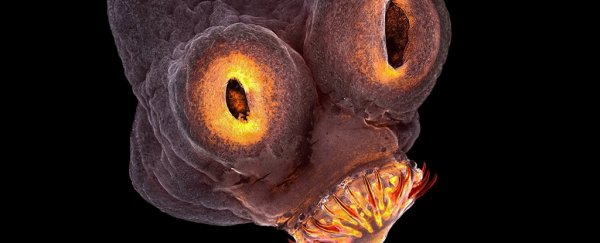A strange and unseen world exists at our fingertips, and only microscopes have the power to bring this hidden dimension into view.
To honour the beauty and scientific importance of microscopic photographs - also called micrographs - the Nikon Small World image contest hands out awards and prizes to researchers and hobbyists who capture the most impressive images.
A handful of independent judges picks the contest's 20 best micrographs, and this year I joined the 43rd judging panel.
We reviewed more than 2,000 pictures from all over the world, and selected the best pictures based on technique, subject matter, and inherent beauty. (We also watched hundreds of stunning videos for the 2017 Nikon Small World in Motion competition.)
The image shown above is a tapeworm's head with all of its spiky mouthparts in stunning detail. To see more of the stunning images the judges saw, keep scrolling.
This image won first place. It shows keratin structures in 'immortalised' human skin cells, which are increasingly important tools for medical researchers:
 Dr. Bram van den Broek, Andriy Volkov, Dr. Kees Jalink, Dr. Nicole Schwarz, and Dr. Reinhard Windoffer/Nikon Small World
Dr. Bram van den Broek, Andriy Volkov, Dr. Kees Jalink, Dr. Nicole Schwarz, and Dr. Reinhard Windoffer/Nikon Small World
This image came in second. It shows the seed-filled head of a groundsel flower:
 Dr. Havi Sarfaty/Nikon Small World
Dr. Havi Sarfaty/Nikon Small World
This Pac-Man-like photo is the third-place winner. It shows a colony of volvox algae bursting open:
 Jean-Marc Babalian/Nikon Small World
Jean-Marc Babalian/Nikon Small World
Here's the full shot of that tapeworm head:
 Teresa Zgoda/Nikon Small World
Teresa Zgoda/Nikon Small World
Fungus grows on a tomato in this image:
 Dean Lerman/Nikon Small World
Dean Lerman/Nikon Small World
These are spores of lily pollen:
 Dr. David A. Johnston/Nikon Small World
Dr. David A. Johnston/Nikon Small World
This part of an embryonic chick brain is coloured with the 'brainbow' genetic technique:
 Dr. Ryo Egawa/Nikon Small World
Dr. Ryo Egawa/Nikon Small World
Sensory hair cells (red) and neurons (green) reveal the structure of a rat cochlea (part of the inner ear):
 Dr. Michael Perny/Nikon Small World
Dr. Michael Perny/Nikon Small World
This cartilage-like tissue was composed and coloured to look like a Christmas tree:
 Catarina Moura, Dr. Sumeet Mahajan, Dr. Richard Oreffo, and Dr. Rahul Tare/Nikon Small World
Catarina Moura, Dr. Sumeet Mahajan, Dr. Richard Oreffo, and Dr. Rahul Tare/Nikon Small World
Two weevils work at passing on their genetic inheritance:
 Dr. Csaba Pinter/Nikon Small World
Dr. Csaba Pinter/Nikon Small World
A close-up of a credit card's holographic logo:
 Steven Simon/Nikon Small World
Steven Simon/Nikon Small World
When you look at a daddy long-legs, these are the eyes looking back at you:
 Charles Krebs/Nikon Small World
Charles Krebs/Nikon Small World
An orchid cuckoo bee shines like metal:
 Levon Biss/Nikon Small World
Levon Biss/Nikon Small World
Two Maestra butterfly eggs are nestled together on a leaf:
 David Millard/Nikon Small World
David Millard/Nikon Small World
A bat foetus with see-through skin and bones:
 Dr. Rick Adams/Nikon Small World
Dr. Rick Adams/Nikon Small World
A great tit bird's down feathers shine like a rainbow under a microscope:
 Marek Mis/Nikon Small World
Marek Mis/Nikon Small World
This dyed human hair is tied into a knot:
 Harald K. Andersen/Nikon Small World
Harald K. Andersen/Nikon Small World
Anchor-like structures line the skin of sea cucumbers:
 Christian Gautier/Nikon Small World
Christian Gautier/Nikon Small World
An impressive profile of a mouse embryo wall:
 Dr. Dylan Burnette/Nikon Small World
Dr. Dylan Burnette/Nikon Small World
A colony of fungus in soil looks like a setting sun:
 Tracy Scott/Nikon Small World
Tracy Scott/Nikon Small World
This article was originally published by Business Insider.
More from Business Insider:
